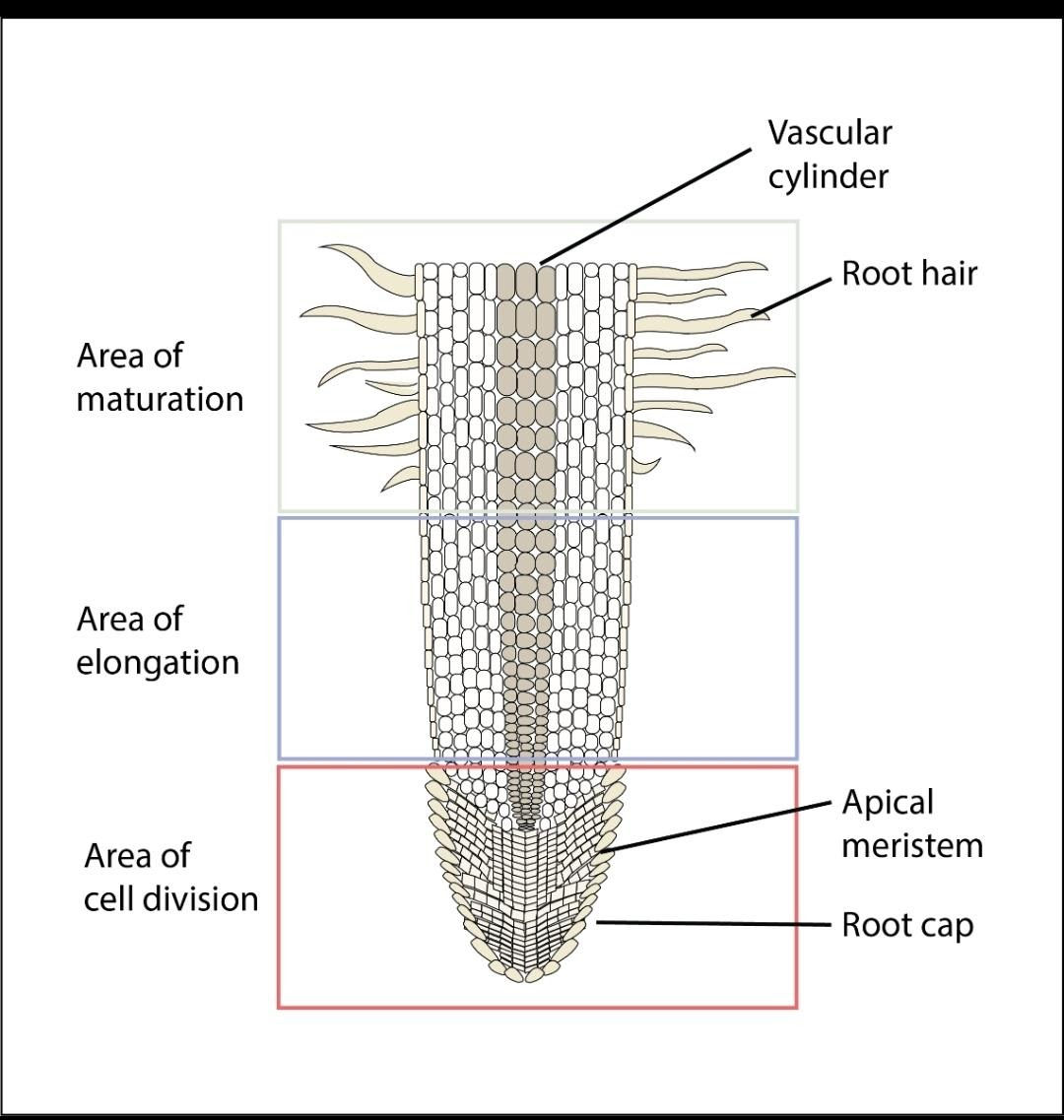
Define the structure of the root.
Answer
395.7k+ views
Hint: Root is a plant organ that supports the absorption of soil nutrients and water. It is found at the end mostly. It consists of three areas: the meristematic zone, the elongation zone and the differentiation zone.
Complete answer:
A typical root system is divided into five regions.
Root cap: The root cap, also known as calyptra, is the root tip. It aids the root in receiving and transmitting environmental signals. It produces mucilage, which aids the plant's penetration of the soil. As the root moves through the soil, it is easily weakened. It also safeguards the meristematic zone.
Meristematic zone (point of development): It is located just above the root tip and provides the root with the basal area. It increases the number of cells in the root cap. Undifferentiated meristematic cells undergo rapid mitosis.
Zone of elongation: increases the root length and lies just behind the meristematic area. This area has external cells that help water and minerals to be absorbed. It lets the root get into the ground deeper.
Zone of differentiation: also, the hair zone of the root. It is the area where xylem, phloem, pericycle, body, periblem and endodermis differentiate. Epiblema cells stretch out to form single-cell root hair.
The maturation zone: It makes up the majority of the root system. Different types of cells emerged as a result of cell differentiation. This zone's primary functions are security, storage, and conductance. The epidermis is the outer layer, the cortex is the deeper layer, and vascular bundles are found in the central area.

Note: The cortex of the root is located between the epidermis and the vascular tissue, while the pith is located between the epidermis and the vascular tissue. Between the root's centre and the vascular tissue is the pith.
Complete answer:
A typical root system is divided into five regions.
Root cap: The root cap, also known as calyptra, is the root tip. It aids the root in receiving and transmitting environmental signals. It produces mucilage, which aids the plant's penetration of the soil. As the root moves through the soil, it is easily weakened. It also safeguards the meristematic zone.
Meristematic zone (point of development): It is located just above the root tip and provides the root with the basal area. It increases the number of cells in the root cap. Undifferentiated meristematic cells undergo rapid mitosis.
Zone of elongation: increases the root length and lies just behind the meristematic area. This area has external cells that help water and minerals to be absorbed. It lets the root get into the ground deeper.
Zone of differentiation: also, the hair zone of the root. It is the area where xylem, phloem, pericycle, body, periblem and endodermis differentiate. Epiblema cells stretch out to form single-cell root hair.
The maturation zone: It makes up the majority of the root system. Different types of cells emerged as a result of cell differentiation. This zone's primary functions are security, storage, and conductance. The epidermis is the outer layer, the cortex is the deeper layer, and vascular bundles are found in the central area.

Note: The cortex of the root is located between the epidermis and the vascular tissue, while the pith is located between the epidermis and the vascular tissue. Between the root's centre and the vascular tissue is the pith.
Recently Updated Pages
Glucose when reduced with HI and red Phosphorus gives class 11 chemistry CBSE

The highest possible oxidation states of Uranium and class 11 chemistry CBSE

Find the value of x if the mode of the following data class 11 maths CBSE

Which of the following can be used in the Friedel Crafts class 11 chemistry CBSE

A sphere of mass 40 kg is attracted by a second sphere class 11 physics CBSE

Statement I Reactivity of aluminium decreases when class 11 chemistry CBSE

Trending doubts
The reservoir of dam is called Govind Sagar A Jayakwadi class 11 social science CBSE

10 examples of friction in our daily life

What problem did Carter face when he reached the mummy class 11 english CBSE

Difference Between Prokaryotic Cells and Eukaryotic Cells

State and prove Bernoullis theorem class 11 physics CBSE

Proton was discovered by A Thomson B Rutherford C Chadwick class 11 chemistry CBSE




